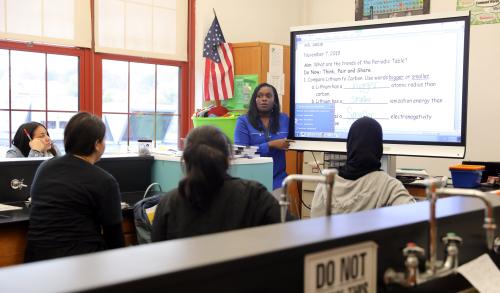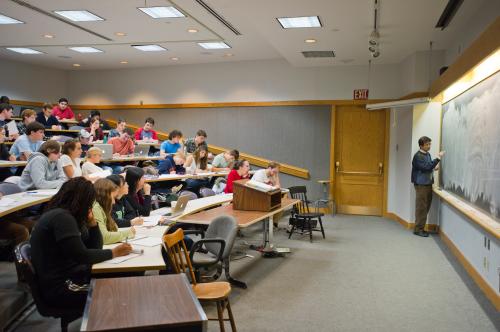This post was produced in collaboration with the academic journal Educational Evaluation and Policy Analysis.
The college completion rate has barely improved for the last 15 years. The latest education statistics show that only about 36% of two-year college students graduate within three years, and less than 60% of four-year college students graduate within six years. For student cohorts that entered college 15 years earlier, the corresponding graduation rates were 33% for two-year college students and 55% for four-year college students.
More alarmingly, despite a substantial decline in racial inequalities in high school completion rates, racial inequalities in college completion rates among college students have been rising or stagnant (Figure 1). In community colleges, the Black–white difference in college completion rate has nearly doubled, increasing from 8 to 15 percentage points between 2000 and 2016. And the Hispanic-white gap over this period changed little, with Hispanic completion rate lower by 8 percentage points. The college completion gaps in four-year colleges largely mirror those found in community colleges.
The persistently low college completion rates likely reflect stubborn deficiencies in college readiness among high school graduates. Roughly 60% of high school graduates are not fully prepared to take college-level coursework, and racial gaps in college readiness measures have changed little during the past decade (Figure 2). Worse, most students who are deemed not college-ready have skill levels far below the established benchmarks: 88% are far below in math; 76% are far below in English.
In response to the college readiness challenge, many states have introduced some form of high school-to-college transition interventions, with the earliest initiatives beginning around 2010. The design and implementation of these interventions vary, but they typically consist of a universal screener for college readiness administered in grade 11, a transition curriculum, and an exit evaluation. The transition curriculum can be an off-the-shelf curriculum, software package, teacher-designed curriculum, or a combination of these.
Most transition programs use college placement tests as the screener, and in some cases, postsecondary faculty, policymakers, and education advocacy organizations collaborate with K-12 administrators and teachers in developing transition curriculum. As a result, many states have been encouraged by the prospects of closer alignment between high school and college expectations and individualized interventions targeting specific proficiency areas. Once hailed as “a solution that is as obvious as it is rare,” transition intervention programs quickly spread to 39 states as of 2017, 17 of which offer statewide transition programs.
Nearly a decade later, rigorous evidence has started to emerge about the efficacy of such programs. This literature relies on a regression discontinuity approach, which is based on the intuition that students at the margin of being college-ready would have had similar future outcomes in the absence of interventions. In other words, any emerging differences between students who narrowly qualified for an intervention and students who narrowly did not qualify could be attributed to the new program.
Unfortunately, the results have been mixed at best. Transition interventions in West Virginia and Florida didn’t appreciably reduce students’ need for remediation upon college entry. And although Tennessee’s transition intervention program reduced remedial math enrollment rates in college by 30 percentage points, these outcomes were driven by a policy that automatically exempted high school students who successfully completed the transition curriculum from college remediation. A post-intervention assessment conducted by researchers found no improvement in student math skills. In each of these states, transition interventions failed to improve students’ chances of passing gatekeeper courses—introductory math and English courses that students are required to pass to graduate.
The latest evidence from Kentucky is slightly more promising. Its statewide transition intervention program, Targeted Interventions (TI), uses the ACT as a universal screener for high school juniors. Benchmarks (scores of 19 in math, 18 in English, and 20 in reading) were established to identify students who may not be on track to be college-ready when graduating high school. Unlike the program in Tennessee, TI does not automatically exempt intervention completers from remediation in college. Unlike the programs in West Virginia and Florida, TI appears to place less emphasis on test preparation. In Kentucky, TI was found to reduce student enrollment in non-credit bearing remedial math courses in college by 8-10 percentage points. Among four-year college students, TI increased the rate at which students enrolled in and passed gatekeeper math courses within the first year of college by 4 percentage points. This suggests that most students who placed out of remediation as a result of TI were ready to succeed in college-level courses.
These are sizable effects relative to the $600 per-student cost. For comparison, each three-credit remedial course in college costs between $830 in community colleges and $1,500 across all institution types. Despite these more encouraging early results, however, TI does not appear to have translated into detectible increases in credit accumulation after the first few years of college, or the rate at which two-year college students successfully transfer to four-year colleges.
The evidence base remains thin not just in terms of the number of research studies, but also because evidence is limited to students near the college-ready thresholds. But based on what we know so far, the benefits of transition interventions are weaker than many of us hoped for.
Perhaps this shouldn’t be surprising. Transition interventions are typically offered during regular school days and provide no additional instructional time. Hoping underprepared students catch up with their peers without expanded learning opportunities may be unrealistic. The nature of learning, particularly in math, is cumulative in that students with higher initial proficiency tend to learn at a faster rate. Conversely, students who start behind rarely catch up. By the final year in high school, transition interventions are likely too little, too late.
Limited instructional time also means transition interventions crowd out regular high school courses such as Algebra II or higher. Because the immediate mandate for transition intervention programs like TI is typically to reduce the need for remediation in college, it is natural for transition curricula to focus on skills required to place out of remediation in college, but not necessarily the more advanced skills needed for later progression through college. There is some evidence of this curriculum trade-off in Kentucky. Students who met the expectations of transition curriculum were less likely to need remediation in college, but they did no better on other measures of progress later on than students who just barely exceeded the eligibility threshold for intervention.
If high school transition interventions are going to move the needle on college completion, they may need to expand—not substitute—learning opportunities for students who need help. Evidence from elementary and middle school grades suggests that increased instruction time has consistently led to better student outcomes, and we expect this would hold in high school grades as well. Perhaps transition interventions could be implemented as after-school or summer school classes, or take the place of electives and not core academic courses.
Though it may be obvious that many students need help as they prepare to transition from high school to college, it’s not obvious that we’ve cracked the code on how to do it right quite yet.
You can read the full journal article in Educational Evaluation and Policy Analysis: “Ready for College? Examining the Effectiveness of Targeted Interventions in High School.”









Commentary
High school transition programs have mixed success in improving college readiness
August 31, 2021